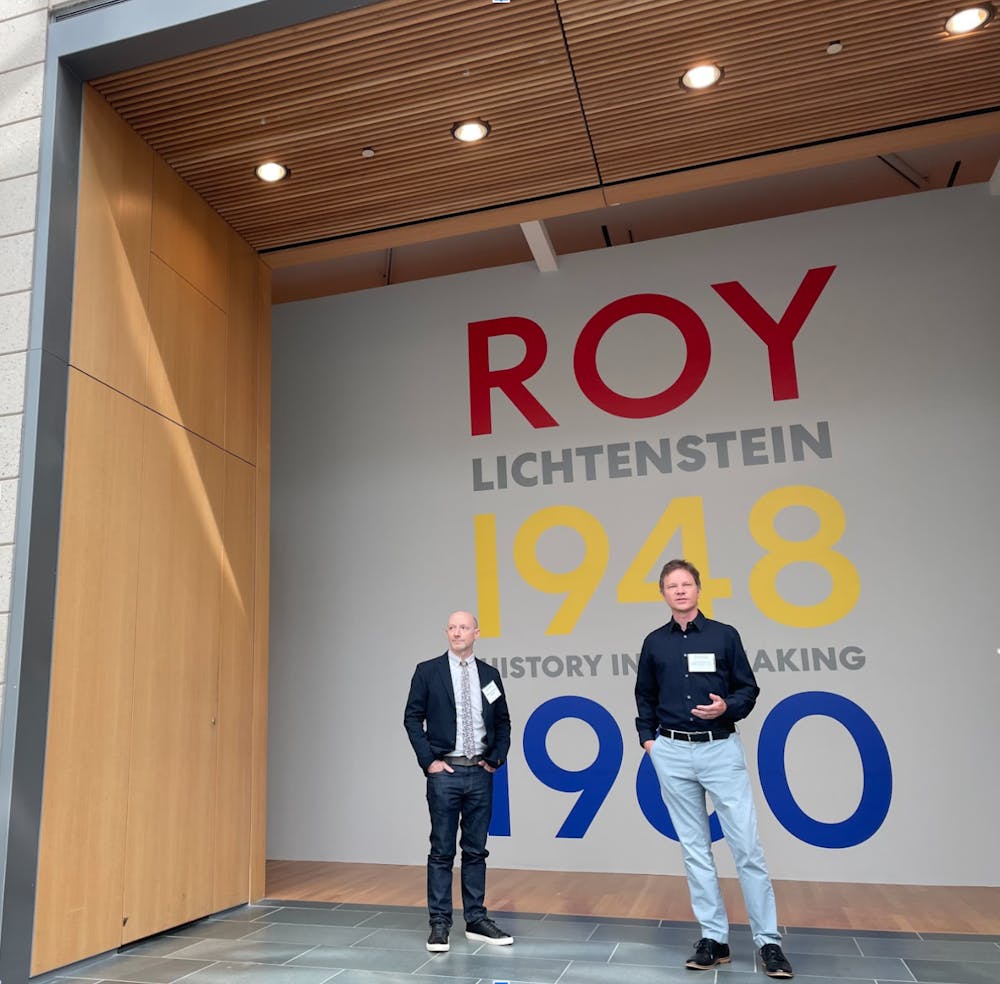Some things arrive late, but just at the right time. The Nasher Museum of Art’s latest exhibition, “Roy Lichtenstein: History in the Making, 1948 - 1960,” opened on August 25 after a two-year postponement due to the COVID-19 pandemic. However, with a current closing date in January 2023, the exhibition makes a celebratory nod to Lichtenstein’s influence on modern art on the cusp of the hundredth anniversary of his birth. As a fitting opening to the long-anticipated showing, the Nasher held its first media preview since the onset of the pandemic on August 24. It was led by Marshall E. Price, Ph. D., Chief Curator and the Nancy A. Nasher and David J. Haemisegger Curator of Modern and Contemporary Art, and saw attendance of over twenty representatives from art and media institutions around the country.
Completing the Story
With iconic works that embodied American Pop art such as "Drowning Girl, 1963" and “Crying Girl, 1964,” Roy Lichtenstein (1923 - 1997) marked his distinct style in the history of modern art. Yet, his was a story that has not been told in full. The foundations of Lichtenstein’s mature signature pieces were grossly overlooked. In addition, Lichtenstein, unlike his Pop Art contemporary Andy Warhol, was not one to ambitiously and strategically make a brand out of his persona. To the general audience, Warhol’s name rings louder than his works, whereas Lichtenstein is perhaps more well-known for his use of the Ben-Day dots method than his public persona. These combined factors create the impression that somehow Lichtenstein’s creations emerged without much context and stood alone amongst a wave of American Pop art.
“Our show is the first exhibition to really take a comprehensive look at his [Roy Lichtenstein’s] career,” Price remarked as he began the preview tour. “Pop arts’ roots run deep, and so certain hallmarks that we can pick up with Pop art creations — humor, archetypes and hero figures — are all already in intersect. It [began] emerging in the late 1920s.” The exhibition zooms back out for a more comprehensive look on Lichtenstein’s artistic career, in which viewers can discover by themselves the interconnectivity of Lichtenstein’s art and larger trends and aesthetics in the post-World War II American society.
Ingredients for Pop
“Life isn’t like cooking. You can’t wait until all the ingredients are ready before you start cooking,” said Chef Chu in Ang Lee’s film “Eat Drink Man Woman.” Lichtenstein’s works from his “pre-Pop” era show viewers that his ingredients for his later, widely acclaimed works were already there.
“[The exhibition] reveals an artist who, from a young age, possessed a keen wit, a sharp eye and an appreciation for irony,” wrote the Co-Curators for this exhibition, Elizabeth Finch and Marshall E. Price, in the introduction of the exhibition catalog. In the late 1940s and early 1950s Lichtenstein returned from serving in World War II in Europe with abundant exposure to great works of art and a new perspective on trends in the United States. He never took the fundamental roots of American culture too seriously, as is evident from his 1951 painting “Washington Crossing the Delaware II.” Already, he was conveying irony and irreverence through image appropriation. “I think that the humor was throughout his entire career,” said Price.
Washington Crossing the Delaware II, c. 1951, Courtesy of the Roy Lichtenstein Foundation
The Ambivalent Experimenter of Americana
Lichtenstein said in a 1963 interview, “I have always had this interest in a purely American mythological subject matter.” Price shared, “[Lichtenstein] was interested in myth and had been all along. It’s not a huge leap to infer that he was quite skeptical of American exceptionalism. It was also a moment of [the] great American exceptionalism in the 1950s. The US won the war and was sort of high on itself, right at the early stages at which this American rhetoric was beginning to ratchet up.” As a perceptive artist, Lichtenstein took note of that shift toward heightened patriotism and exceptionalism. As a result of his societal observations in this period, he began experimenting with Disney cartoons in his painting after “Mickey Mouse Club” enjoyed immense success. This series of works speaks to the ambivalence of Lichtenstein’s nature as a detached observer. When asked whether Lichtenstein considered these comics and cartoons as a type of urban American myth, Price echoed the comment that he saw them as part of the American culture, saying that Lichtenstien “probably loved them for [part of the culture].” Liechtenstein even once said, “The things I apparently parodied I actually admire, and I really don’t know what the implication of that is.” That is, while satirical sentiments appear in many of Lichtenstein’s pieces, he was not always critical. A sense of calm playfulness is instead what pervades nearly all of his art.
Mickey Mouse I, c. 1958. Courtesy of the Morgan Library & Museum
Lichtenstein saw the established norms and tastes of society as an endless source for satire. Yet precisely how much he intended to satire and how much he in fact identified with those cultural patterns remains unsolved. In many ways, by critiquing elements of American pop culture, he also perpetuated what is still now considered quintessentially “American” in art. He appropriated from, played with, reassembled and dissected history, but what he might not have known was that all the while history contributed to the making of his work, his work also played a part in the making of history.
Get The Chronicle straight to your inbox
Signup for our weekly newsletter. Cancel at any time.
Katherine Zhong is a Trinity junior and local arts editor of The Chronicle's 119th volume.

